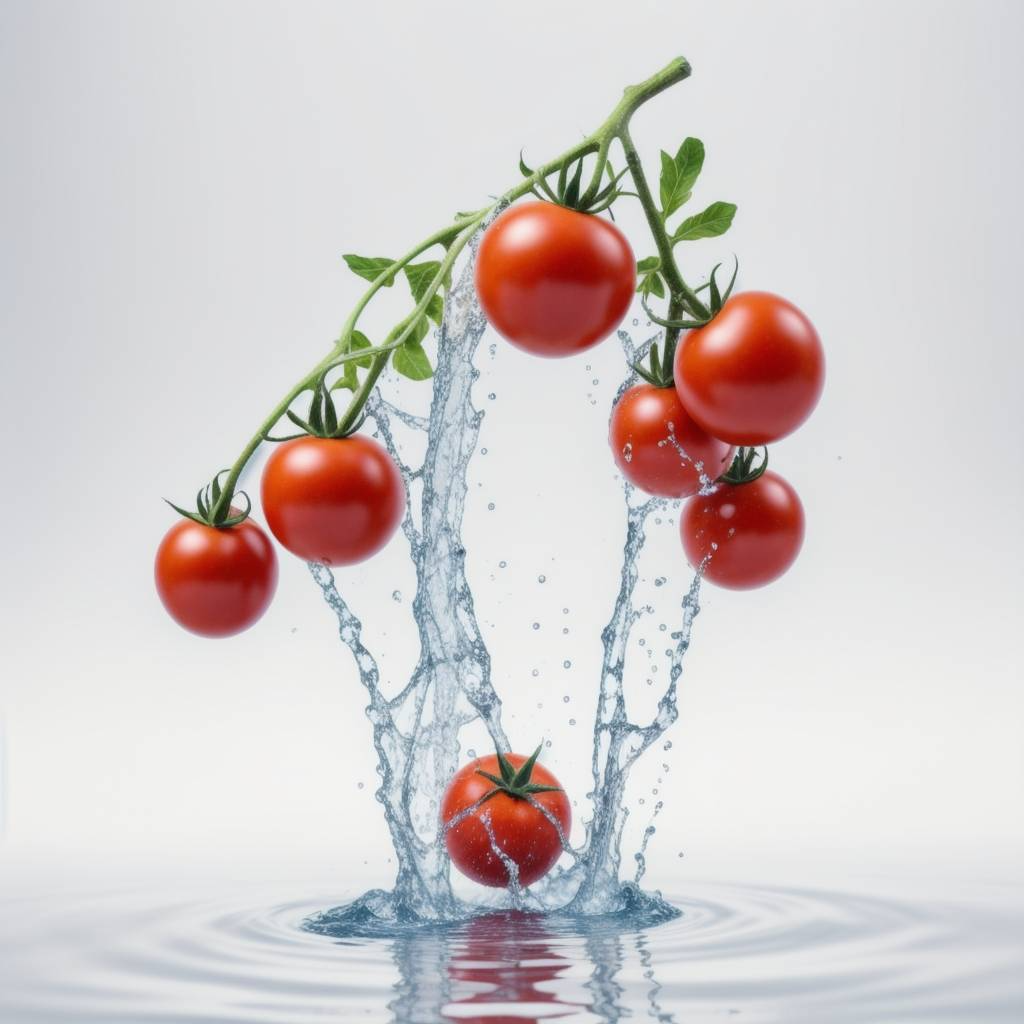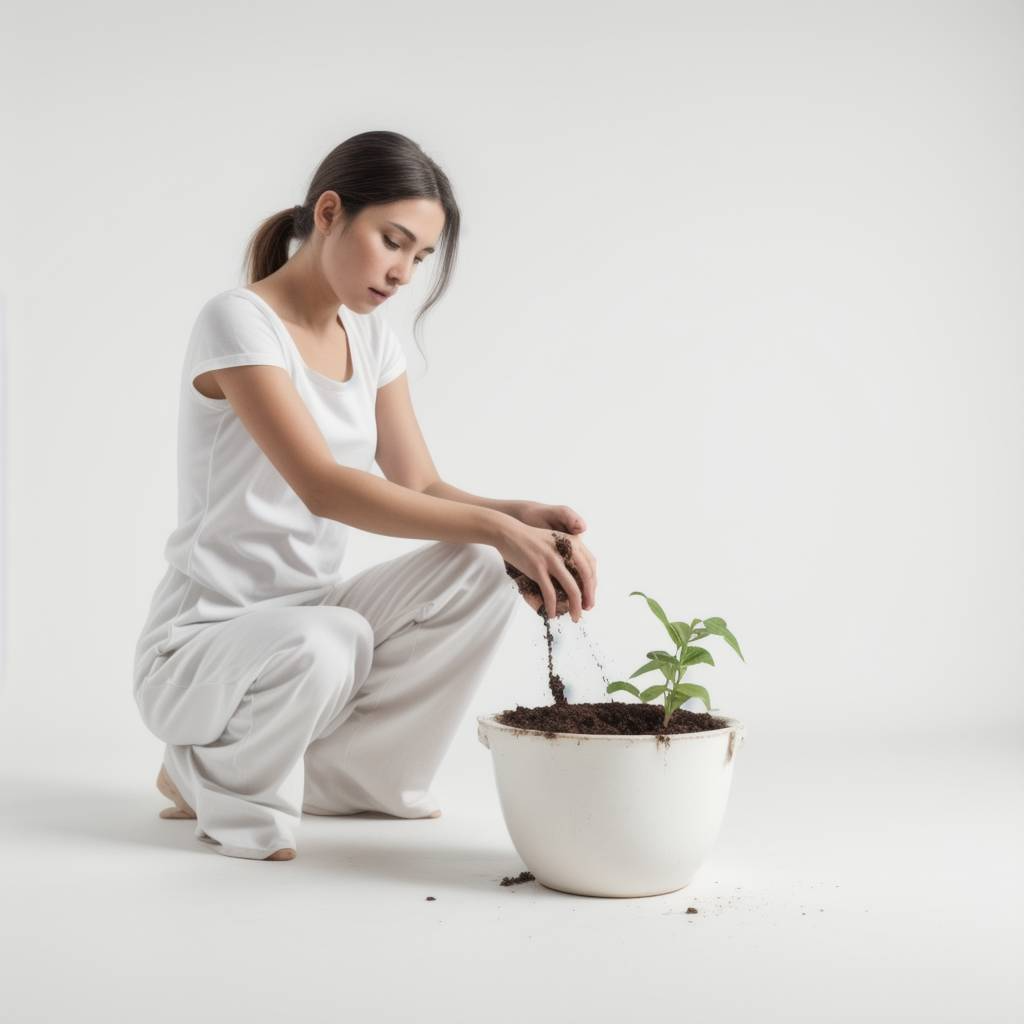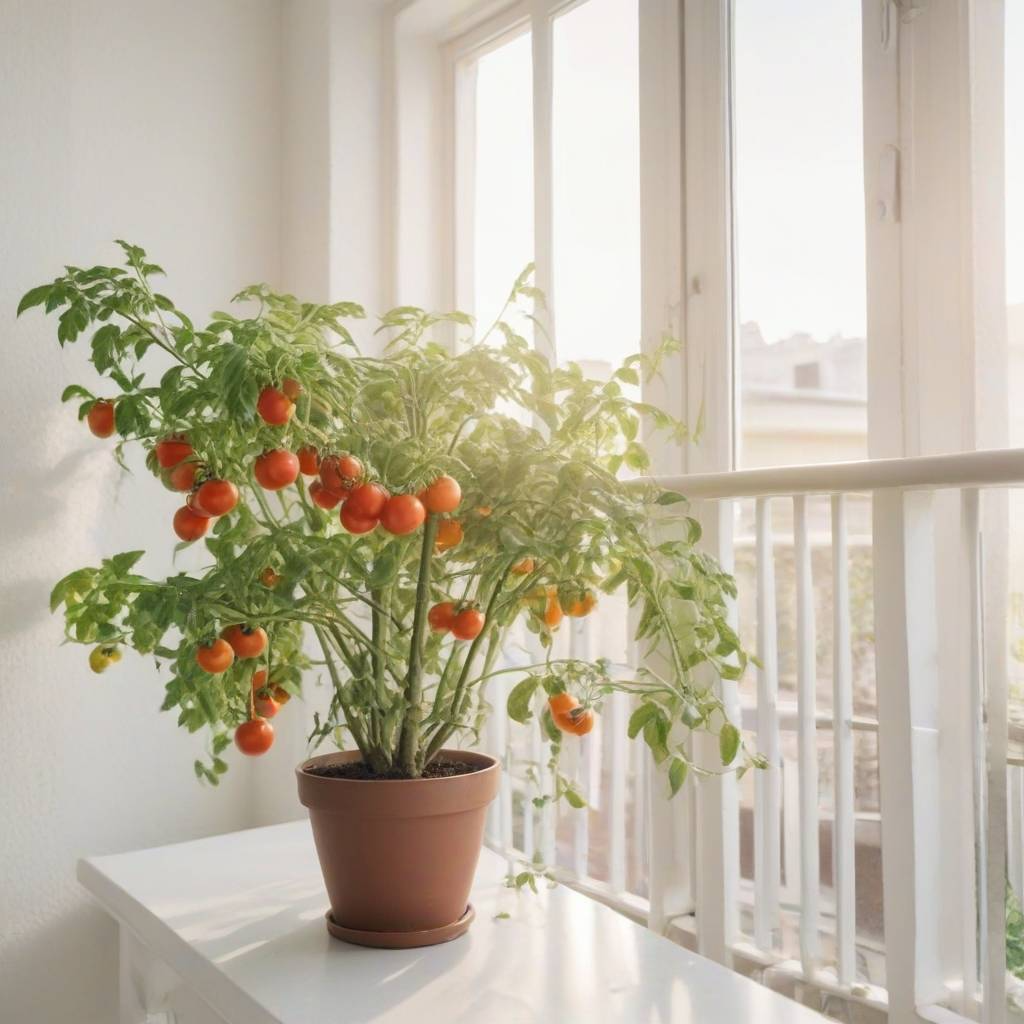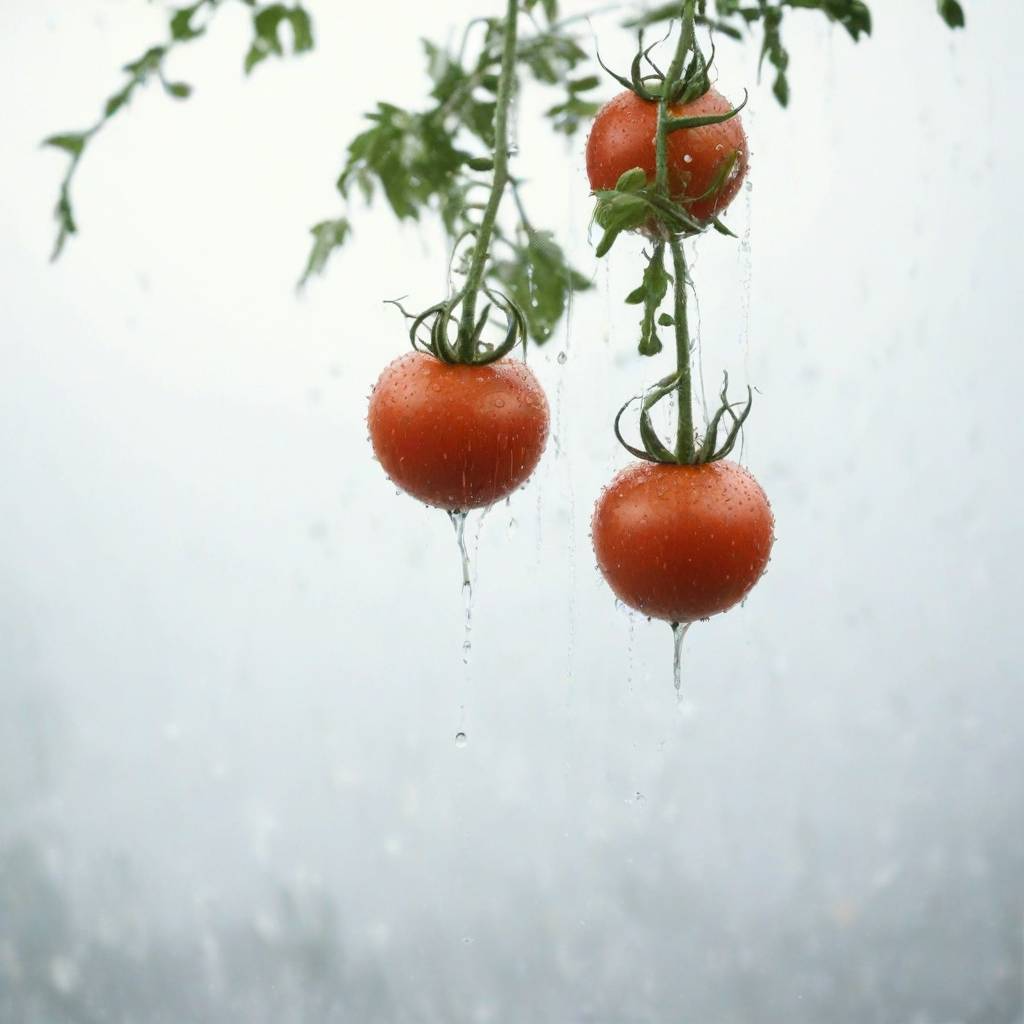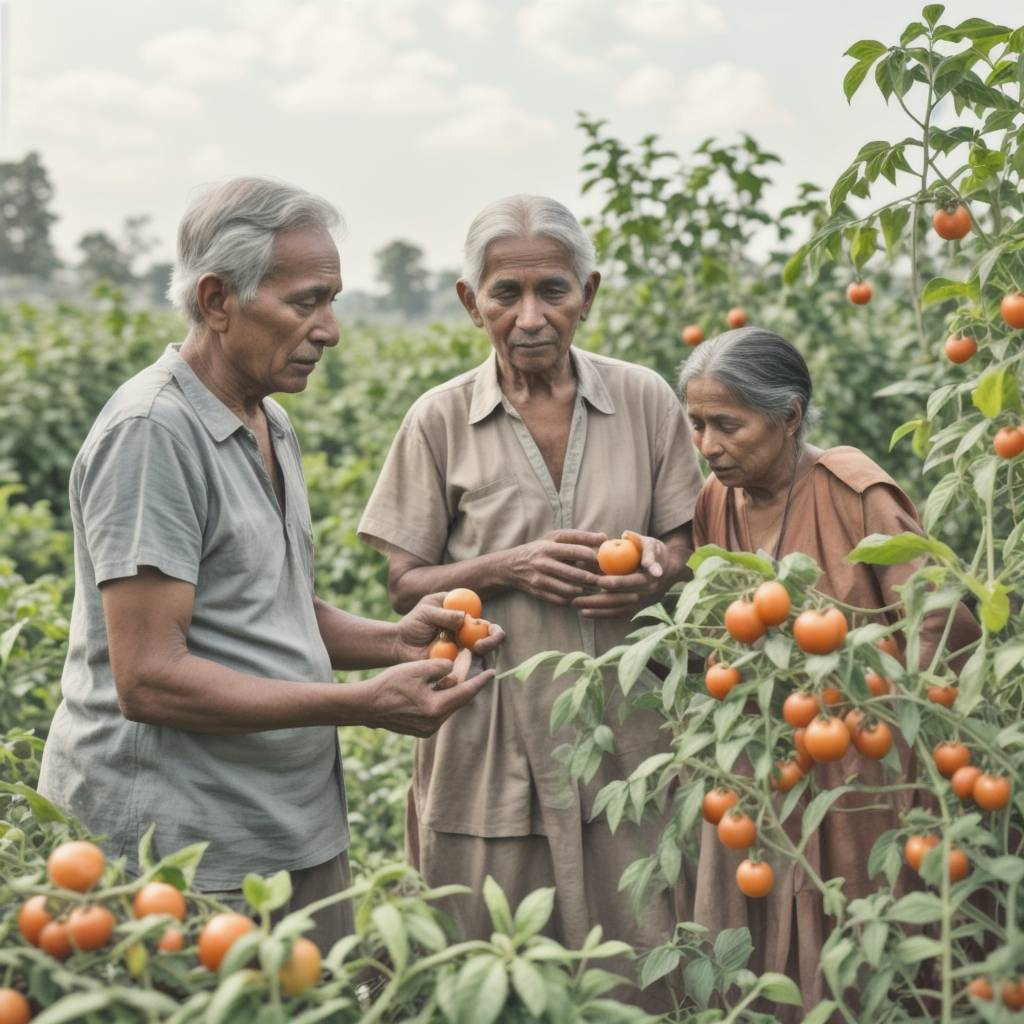Tomatoes🍅 , often mistaken for vegetables, are actually fruits belonging to the nightshade family. Originating from South America, they have journeyed across the globe, becoming a staple in various cuisines due to their versatility and rich nutritional profile. One of the most fascinating aspects of tomatoes is their variety. From the tiny cherry tomatoes that burst with sweetness to the large beefsteaks perfect for sandwiches, there’s a type for every culinary need. Varieties like Roma are ideal for sauces, while heirlooms, with their unique colors and flavors, are often featured in salads and gourmet dishes.
Nutritionally, tomatoes are powerhouses. They are rich in vitamins A and C, potassium, and folate. Their vibrant red color comes from lycopene, a powerful antioxidant linked to numerous health benefits, including reduced risk of heart disease and cancer. Lycopene is more easily absorbed by the body when tomatoes are cooked, making dishes like tomato sauce not just tasty but also highly nutritious. Tomatoes are incredibly versatile in the kitchen. They can be eaten raw, cooked, or dried. Fresh tomatoes are perfect for salads, salsas, and sandwiches. Cooked, they form the base of countless sauces, soups, and stews. Sun-dried tomatoes add a burst of concentrated flavor to various dishes. Their umami-rich profile enhances the taste of many foods, making them a favorite among chefs and home cooks alike.
Growing tomatoes is also popular among gardeners, both outdoors and indoors. With the right conditions—plenty of sunlight, warmth, and water—they can thrive and produce a bountiful harvest. Varieties like Tiny Tim and Patio Princess are especially suited for indoor gardening, allowing even those with limited space to enjoy home-grown tomatoes. In summary, the tomato is a remarkable fruit that enriches our diets and cuisines. Whether you’re savoring a fresh tomato salad, a hearty tomato soup, or a homemade tomato sauce, this versatile fruit proves itself indispensable in the culinary world. lets Explore The Little world of tomatoes with Zardens
Choosing the Right Variety of Tomatoes for Indoor Gardening
Indoor gardening is a delightful way to enjoy fresh produce year-round, and tomatoes are one of the most rewarding plants to grow indoors. However, to ensure success, selecting the right variety is crucial. Not all tomatoes are created equal, especially when it comes to indoor cultivation. Let’s dive into the best varieties to bring a splash of summer to your indoor garden.
Why Variety Matters
Choosing the right tomato variety is like picking the perfect pair of shoes: the right fit makes all the difference. Indoor growing conditions differ significantly from outdoor ones. Space constraints, light availability, and container limitations all play a role in how well your tomatoes will thrive indoors. Here are some key factors to consider:
- Size Matters: Indoor spaces usually can’t accommodate sprawling vines. Opt for compact or dwarf varieties.
- Determinate vs. Indeterminate: Determinate varieties grow to a set height and produce all their fruit at once, making them easier to manage indoors.
- Fruit Size: Smaller fruiting varieties often perform better indoors, as they require less energy and space to mature.
Top Varieties for Indoor Gardening
1. Tiny Tim Tiny Tim is the poster child for indoor tomato growing. This dwarf variety reaches about 12-18 inches in height, making it perfect for small spaces. Despite its size, it produces a generous crop of bright red, cherry-sized tomatoes that are sweet and delicious.
2. Patio Princess If you’re looking for a tomato plant that doubles as a decorative plant, Patio Princess is your go-to. This compact variety grows about 18-24 inches tall and offers a continuous supply of small, flavorful tomatoes. It’s not just productive but also visually appealing, with a lush, bushy appearance.
3. Red Robin Red Robin is another excellent choice for indoor gardeners. This tiny dynamo grows only 8-12 inches tall but is prolific, yielding an abundance of small, red cherry tomatoes. It’s particularly well-suited to grow under artificial lights, making it a favorite among indoor gardening enthusiasts.
4. Yellow Canary For a splash of color, try Yellow Canary. This variety produces small, yellow tomatoes that are as sweet as they are eye-catching. Growing to about 12-15 inches, it fits perfectly on a sunny windowsill or under grow lights. The bright yellow fruit adds a cheerful touch to any indoor garden setup.
Tips for Success
- Light: Even the best varieties need plenty of light. Ensure your tomatoes get 14-18 hours of light daily, using grow lights if necessary.
- Watering: Keep the soil consistently moist but not waterlogged. Indoor conditions can dry out soil quickly, so regular checks are essential.
- Support: Despite their compact size, many dwarf varieties benefit from some support. Small stakes or cages can help keep plants upright and healthy.
Soil Basics: The Foundation of Your Tomato Success
No matter the variety, all tomatoes thrive in well-draining, nutrient-rich soil. Here’s a step-by-step guide to preparing the perfect soil mix for your tomato plants. Start with a soil test. This helps you understand the pH and nutrient levels of your soil. Tomatoes prefer a slightly acidic to neutral pH (6.0-7.0). Soil testing kits are available at garden centers or you can send a sample to a local extension service.
Amending the Soil
Based on your soil test results, you’ll need to amend your soil. Here’s what you’ll need:
- Organic Matter: Add compost or well-rotted manure to improve soil structure and fertility. Aim for about 3-4 inches mixed into the top 12 inches of soil.
- Adjusting pH: If your soil is too acidic, add lime. If it’s too alkaline, use sulfur or composted pine needles to lower the pH.
- Nutrients: Incorporate a balanced fertilizer. Look for one with an N-P-K ratio of around 5-10-10, which means it has more phosphorus and potassium to support fruit development.
Special Considerations for Different Varieties
Now, let’s tailor the soil prep for specific tomato types.
Determinate Tomatoes
These varieties need soil that supports rapid growth and fruiting over a short period. Focus on:
- Nutrient Density: Ensure the soil is rich in nutrients with plenty of compost.
- Consistency: Maintain even moisture levels to prevent blossom end rot, a common issue for determinate varieties.
Indeterminate Tomatoes
These long growers require a steady supply of nutrients and strong root support.
- Deep Soil: These varieties benefit from deeper soil prep. Dig down at least 18 inches to accommodate their extensive root systems.
- Ongoing Fertilization: Plan to side-dress with compost or a balanced fertilizer every few weeks to sustain their growth.
Heirloom Tomatoes
Heirlooms are often more sensitive and need a bit more TLC.
- Rich Organic Matter: Heirlooms thrive in soil loaded with organic matter. Use compost, leaf mold, and even aged manure.
- Mulching: Mulch heavily around heirlooms to retain moisture and regulate soil temperature.
Before planting, ensure the soil is loose and well-aerated. Avoid compacting the soil, as tomatoes need good drainage and root expansion.
Tailoring Light Requirements for Different Tomato Varieties
Growing tomatoes indoors is a gratifying adventure, but it comes with its unique set of challenges. One of the most crucial elements to get right is lighting. Different tomato varieties have different light needs, and understanding these can make the difference between a bountiful harvest and a disappointing crop. Let’s dive into the light requirements for various tomato varieties and how you can optimize your indoor garden for success.
The Basics of Tomato Lighting
Before we explore specific varieties, it’s important to understand why light is so essential for tomatoes. Tomatoes are sun-loving plants that thrive on ample light to produce energy through photosynthesis. This energy fuels their growth, flowering, and fruiting processes. When growing indoors, replicating the natural sunlight they crave is key to achieving healthy, productive plants.
Tiny Tim: The Compact Contender
Tiny Tim tomatoes are a favorite for indoor gardeners due to their compact size and prolific nature. These dwarf tomatoes only grow about 12-18 inches tall, making them perfect for windowsills or small spaces. Despite their size, they still demand a lot of light. Aim for:
- Light Duration: 14-16 hours per day
- Light Intensity: Medium to high intensity; LED grow lights positioned 2-4 inches above the plant work best.
Patio Princess: The Indoor Royalty
Patio Princess tomatoes are another excellent choice for indoor cultivation. These determinate plants stay manageable in size while offering a generous yield. To keep your Patio Princess thriving:
- Light Duration: 12-14 hours per day
- Light Intensity: Moderate intensity; a combination of natural light from a sunny window and supplemental LED grow lights can be effective.
Red Robin: The Cherry Champion
Red Robin tomatoes are beloved for their small, sweet cherry tomatoes and ease of growth indoors. These determinate plants are quite adaptable but still need sufficient light to produce their signature fruit:
- Light Duration: 14-16 hours per day
- Light Intensity: Medium intensity; place LED grow lights about 3-4 inches above the plants to ensure even light distribution.
Yellow Canary: The Bright Bloomer
Yellow Canary tomatoes are known for their vibrant yellow fruit and compact growth habit. These tomatoes bring a splash of color to any indoor garden and require:
- Light Duration: 14-16 hours per day
- Light Intensity: High intensity; LED grow lights positioned close to the plant (about 2-3 inches) will help maintain their bright, sunny hue.
Lighting Tips for Indoor Tomato Success
- Consistent Lighting Schedule: Use timers to maintain a consistent light schedule. This helps mimic the natural daylight cycle and promotes steady growth.
- Adjustable Lighting: As your tomato plants grow, adjust the height of your grow lights to keep them at the optimal distance. Too close, and you risk burning the plants; too far, and they may become leggy and weak.
- Light Quality: Full-spectrum LED grow lights are ideal as they provide a balance of red, blue, and other wavelengths that mimic natural sunlight and support all stages of growth.
- Reflective Surfaces: Enhance light efficiency by placing reflective materials like mylar or white surfaces around your plants. This helps bounce light back onto the plants, ensuring they receive as much light as possible.
Watering Different Tomato Varieties for Perfection
Tomatoes are the jewels of the garden, bursting with flavor and vibrant color. Whether you’re growing beefsteak, cherry, or heirloom varieties, watering is a critical factor that can make or break your harvest. Let’s dive into the art of watering different types of tomatoes, ensuring your plants thrive and produce the juiciest fruits.
Beefsteak Beauties: A Thirsty Affair
Beefsteak tomatoes are the giants of the tomato world, known for their large, meaty fruits. These hefty plants require consistent moisture to support their vigorous growth and fruit development.
Watering Tips:
- Frequency: Water beefsteak tomatoes deeply once or twice a week, ensuring the soil is evenly moist.
- Volume: Aim for about 1-1.5 inches of water per week, depending on the weather and soil type.
- Technique: Use a soaker hose or drip irrigation to deliver water directly to the roots, minimizing leaf wetness and reducing the risk of fungal diseases.
Cherry Tomatoes: Tiny Treasures with Big Needs
Cherry tomatoes, with their small size and explosive flavor, are a favorite for salads and snacking. Despite their petite fruits, these plants can be quite thirsty, especially in containers.
Watering Tips:
- Frequency: Cherry tomatoes prefer more frequent watering, about every 2-3 days, especially in hot weather.
- Volume: Ensure the soil stays consistently moist but not waterlogged. In containers, water until you see it draining out of the bottom.
- Technique: Mulch around the base of the plants to retain moisture and keep the soil cool.
Heirloom Varieties: The Delicate Balance
Heirloom tomatoes are prized for their unique flavors and colors. These varieties can be a bit finicky, and their watering needs vary slightly compared to hybrids.
Watering Tips:
- Frequency: Heirlooms benefit from consistent moisture, so water them deeply once a week.
- Volume: About 1 inch of water per week is usually sufficient, but adjust based on rainfall and temperature.
- Technique: Water early in the morning to allow foliage to dry during the day, reducing disease risk. Mulching is also beneficial to maintain soil moisture levels.
Container Tomatoes: Custom Care
Growing tomatoes in containers is a fantastic way to enjoy fresh produce even in limited space. However, containers dry out faster than garden soil, requiring more diligent watering.
Watering Tips:
- Frequency: Check the soil daily, and water thoroughly when the top inch feels dry.
- Volume: Water until it flows out of the drainage holes to ensure the entire root ball gets hydrated.
- Technique: Use self-watering containers if possible, which provide a steady moisture supply.
General Watering Wisdom
Regardless of the variety, there are some universal tips for watering tomatoes effectively:
- Consistency is Key: Irregular watering can lead to problems like blossom end rot and splitting fruit.
- Avoid Overhead Watering: Wet leaves can promote fungal diseases. Water at the base of the plant.
- Monitor the Weather: Adjust your watering schedule based on rainfall, humidity, and temperature.
Mastering Pruning and Support for Different Tomato Varieties
Tomatoes are a gardener’s delight, bursting with flavor and vibrant colors. But to truly get the best out of your tomato plants, understanding the nuances of pruning and support is crucial. Whether you’re growing indeterminate giants or compact determinate varieties, each type has its own set of needs. Let’s dive into the art of pruning and supporting your tomatoes to ensure a bountiful harvest!
Indeterminate Varieties: Reaching for the Sky
Indeterminate tomatoes, also known as vining tomatoes, can grow indefinitely, often reaching heights of 6-10 feet or more. These varieties, like ‘Beefsteak’, ‘Cherokee Purple’, and ‘Sungold’, need diligent pruning and sturdy support to thrive.
Pruning Tips for Indeterminate Tomatoes:
- Remove Suckers: These small shoots develop in the leaf axils (the point where the leaf stem meets the main stem). While some gardeners prefer to let a few suckers grow, removing most of them directs the plant’s energy into producing larger, juicier tomatoes.
- Top the Plant: Once the plant reaches the top of its support structure, pinch out the growing tip to encourage fruit ripening rather than further vertical growth.
Support Systems for Indeterminate Tomatoes:
- Stakes: Use tall, sturdy stakes (at least 6 feet) and tie the main stem loosely with garden twine as it grows.
- Cages: Opt for large, robust cages that can support the plant’s weight and allow for easy access to the fruit.
- Trellises: A-frame or vertical trellises provide excellent support and make harvesting a breeze.
Determinate Varieties: Compact and Contained
Determinate tomatoes, or bush tomatoes, such as ‘Roma’, ‘Celebrity’, and ‘Bush Early Girl’, grow to a fixed size, typically 3-4 feet tall. They produce fruit in a shorter, more concentrated period and require different pruning and support strategies.
Pruning Tips for Determinate Tomatoes:
- Minimal Pruning: Determinate varieties benefit from minimal pruning. Removing too many leaves or suckers can reduce your overall yield.
- Remove Lower Leaves: To improve air circulation and reduce disease risk, trim the leaves that touch the ground or appear yellowed and unhealthy.
Support Systems for Determinate Tomatoes:
- Cages: Standard tomato cages work well, providing adequate support without overbearing the compact plants.
- Stakes: Shorter stakes (3-4 feet) are sufficient. Tie the plants as they grow to keep them upright and prevent branches from breaking under the weight of the fruit.
Semi-Determinate Varieties: The Best of Both Worlds
Semi-determinate tomatoes, like ‘San Marzano’ and ‘Mountain Magic’, offer a blend of traits from both indeterminate and determinate varieties. They grow taller than determinate plants but are more manageable than their indeterminate counterparts.
Pruning Tips for Semi-Determinate Tomatoes:
- Moderate Pruning: Remove some suckers to prevent overcrowding and improve airflow but leave enough foliage to support the plant’s growth and fruiting.
Support Systems for Semi-Determinate Tomatoes:
- Medium Stakes or Cages: Use supports that are sturdy but not as tall as those required for indeterminate varieties. A combination of stakes and cages can provide excellent support.
Why Pruning and Support Matter
Proper pruning and support are not just about aesthetics; they significantly impact the health and productivity of your tomato plants. By pruning, you manage the plant’s energy, directing it towards fruit production rather than excessive foliage. Meanwhile, robust support systems prevent the plants from sprawling, reducing the risk of disease and making harvesting easier
Each tomato variety has unique needs, but with the right pruning and support strategies, you can optimize their growth and enjoy a delicious, abundant harvest. Experiment with different methods to see what works best in your garden, and watch your tomato plants flourish like never before. Happy gardening!
FRP Container Selection for Growing Tomatoes Indoors
Hello, fellow green thumbs! 🌱 If you’re anything like me, the sight of fresh, juicy tomatoes ripening indoors is nothing short of a miracle. Today, I’m diving into a crucial but often overlooked aspect of indoor tomato gardening: selecting the right FRP (Fiber Reinforced Plastic) containers for different tomato varieties. Let’s make sure your tomatoes get the perfect home they deserve!
Why FRP Containers?
Before we get into specifics, let’s talk about why FRP containers are a fantastic choice for growing tomatoes. These containers are lightweight yet incredibly durable, offering excellent resistance to weather and UV rays. Their non-porous surface prevents soil from drying out too quickly, and they’re available in a plethora of shapes and sizes to suit any indoor garden setup.
Matching Containers to Tomato Varieties
Dwarf Varieties (Tiny Tim, Red Robin)
Dwarf tomato plants are compact and bushy, making them perfect for smaller spaces. For these little gems, opt for FRP containers that are around 2-3 gallons. A cylindrical or square pot works well, providing enough root space without overwhelming your indoor garden.
- Recommended Size: 2-3 gallons
- Shape: Cylindrical or square
- Tip: Ensure good drainage with pre-drilled holes or add a layer of gravel at the bottom.
Determinate Varieties (Patio Princess, Celebrity)
Determinate tomatoes grow to a fixed mature size, usually around 3-4 feet tall. They need a bit more room to spread their roots but don’t require as much depth as indeterminate varieties. FRP containers that are 5-7 gallons are ideal for these types.
- Recommended Size: 5-7 gallons
- Shape: Round or rectangular
- Tip: Use a tomato cage or stakes to support the plant as it grows.
Indeterminate Varieties (Big Boy, Beefsteak)
These are the giants of the tomato world, continuously growing and producing fruit throughout the season. Indeterminate tomatoes need the largest containers you can manage indoors. Look for FRP containers that are at least 10 gallons or more.
- Recommended Size: 10+ gallons
- Shape: Deep and round
- Tip: Provide strong support with a trellis or sturdy cage. These plants will climb and sprawl, needing ample space to thrive.
Choosing the Right FRP Container Design
While size is the most critical factor, the design also plays a significant role in the health and productivity of your tomato plants. Here are a few design features to consider:
- Color: Lighter colors reflect heat, keeping the soil temperature regulated. Darker colors can absorb heat, which might be beneficial in cooler indoor environments.
- Mobility: Containers with wheels make it easy to move your plants to catch the best sunlight throughout the day.
Final Thoughts
Tomato Tales: Unraveling The Diversity of Tomato Varieties” highlights the rich variety of tomatoes, including heirlooms and hybrids, each offering unique flavors, colors, and uses. For successful cultivation, the guide emphasizes choosing the right planter, preferably FRP (Fiber Reinforced Plastic) due to its durability, lightweight nature, and resistance to weather. Key growing tips include selecting the appropriate tomato variety for your climate, ensuring proper sunlight, and maintaining soil health with regular watering and fertilizing. By combining these insights, gardeners can enhance their tomato-growing experience, achieving a bountiful and diverse harvest.
I hope this guide helps you pick the perfect FRP containers for your indoor tomato garden. Happy planting, and may your indoor space be filled with the delicious aroma of fresh tomatoes soon! Explore The Little world of tomatoes with Zardens
Until next time, happy gardening! 🌿🍅

